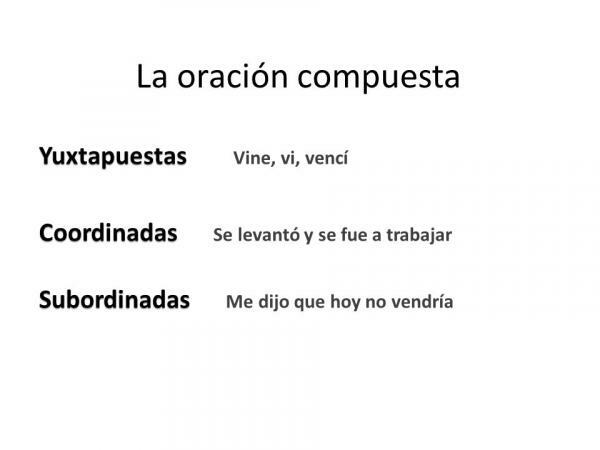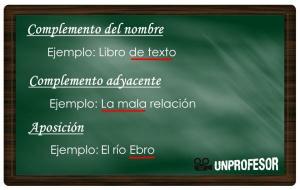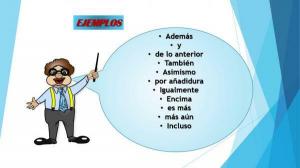Types of juxtaposed, coordinated and subordinate SENTENCES

In Spanish there are two different types of sentences depending on whether they have one or more conjugated verbs: simple sentences (which are those that are formed around a single verb) and compound sentences, which contain more than one phrase verbal. In this lesson from a TEACHER we will study the three types of compound sentences: juxtaposed sentences, coordinated sentences and, finally, subordinate sentences. With us you will learn to differentiate one from the other and analyze them correctly. Read on and discover the different juxtaposed, coordinate and subordinate sentence types!
Index
- Juxtaposed sentences
- Coordinated Sentences
- Subordinate clauses
- Examples of juxtaposed, coordinated, and subordinate sentences
Juxtaposed sentences.
Juxtaposition is the union of two or more elements linguistics within the same level of parsing. The main characteristic of juxtaposed sentences is that they are linked via graphic or punctuation marks, like commas, for example, without using a word that works as a nexus.
This characteristic also helps us to differentiate juxtaposed sentences from sentences coordinated or subordinate, since these do require the presence of a link that unites both prayers.
Also, since there is no link, both the first and second sentences are within the same level of syntactic analysis; namely, there is no main sentence and another proposition that is subordinate, but both are on the same syntactic plane, so they can also be exchanged with each other without problem, as in the following example:
Lorena sleeps, Clara reads a novel
It is a juxtaposition because the two parts are joined by a comma and you can change the order and say Clara reads a novel, Lorena sleeps.
In this lesson from a TEACHER we will discover what are the juxtaposed sentences with examples.
Coordinated sentences.
Through the coordination of sentences we form a compound sentence in which two sentences are coordinated with each other. The main defining characteristic of coordinate sentences is that each of the two propositions are syntactically independent; that is, each of them has complete meaning on its own.
For example, You cook and I wash the dishes they are two propositions that form a sentence composed by coordination. Both sentences are joined by the copulative conjunction "and", and we can state them separately I wash the dishes or also You cook; in the same way, we can reverse the order I wash the dishes and you cook.
What are coordinated sentences and what types exist
We are going to review the concept of coordinated sentences so that you understand the lesson better. A coordinated sentence is a compound sentence that is independent one from the other, but that are united to form a single sentence thanks to a coordinating nexus. This means that this type of sentence could work perfectly individually and, in addition, the elements can be interchanged and continue to work.
For example: Laura studies at home and Mireia makes the food. In this case, they are two independent sentences that are joined with the conjunction "and" but if they are read alone, they are perfectly understood. But, in addition, we could say that Laura makes the food and Mireia studies at home and they would continue to understand each other.
The different types of coordinated sentences that exist are:
- Copulative coordinate sentences
- Disjunctive coordinate sentences
- Adversative coordinated sentences

Subordinate clauses.
However, if we follow the previous example You cook and I wash the dishes but instead of formulating it like this we say You cook whenever I do the dishes we can see that, although the idea we want to convey is the same, the parsing of the sentences is completely different.
In this last example, the second proposition appears subordinate to the first; it is therefore a subordinate clause. The main characteristic of subordinate clauses is that these are formed from a main verb on which a proposition depends, which does not have its own meaning but has to join the main one through a subordinate nexus.
Going back to the previous example You cook whenever I do the dishes, we observe that there is a main sentence, independent and autonomous by itself, which is You cook, as well as a subordinate clause, which is joined to the first by the nexus as long as, which is a subordinate adverbial phrase that introduces a condition.
Thus, the prayer as long as I wash the dishes It is a conditional adverbial subordinate sentence since it does not have syntactic independence and is subordinate to the main proposition. In this video of a PROFESSOR we discover the subordinate clause types that exist in Spanish.
Definition of subordinate clauses and types
To make this lesson clear to you, it is important to know what subordinate clauses are. They are a type of sentence that are part of compound sentences and subordination establishes an order of importance within the sentence. A link is required that unites the two sentences and that is the one that will indicate the relationship between them.
There are different subordinate clause types:
- Subordinate Nouns: In these cases, the subordinate clause acts as a CI, CD, CN, Subject or CAdv.
- Subordinate Adjectives or Relative: are the sentences that are introduced by means of a relative pN, a relative adverb or a relative determinant.
- Adverbial subordinates: they are another type of subordinate clause and work like a CC.

Examples of juxtaposed, coordinated and subordinate sentences.
To finish this lesson on the types of juxtaposed coordinated and subordinate sentences, below we are going to provide you with some examples of these sentences so that you can finish better understanding all the contents that we have indicated.
Examples of juxtaposed sentences
- María reads a book, Marcos prepares dinner.
- We are coming soon, no one will have arrived yet.
- The effort paid off: I won the contest.
- Lucas will be when he falls, I guess.
- They didn't tell us anything else, the situation was very delicate.
- It is not worth taking the car, we can walk.
Examples of coordinated sentences
- We arrive early so we have time to have a leisurely breakfast.
- I failed the exam, but they let me get the scholarship.
- This winter it has rained a lot, so there is a lot of vegetation.
- The movie has already started and Juan hasn't parked yet.
- Your answers are good so you can pass the exam.
Examples of subordinate clauses
- The car that I rented did not work well.
- I bought the pink dress that you liked so much.
- You cannot go to bed even if you are tired.
- The doors that were broken have already been fixed.
- The recipe you showed me was delicious.
If you want to read more articles similar to Types of juxtaposed, coordinated and subordinate sentences, we recommend that you enter our category of Grammar and Linguistics.



